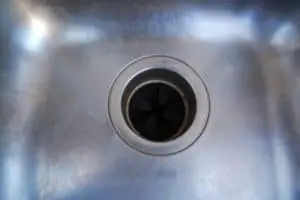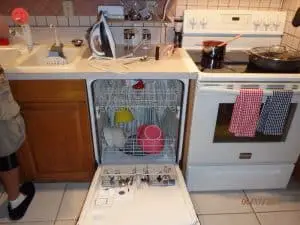During one of your busy kitchen sessions, you probably felt the need to multitask by turning on the dishwasher while emptying your lunch leftovers in the garbage disposal unit.
You may have felt the need to run these two kitchen devices simultaneously at some point, whether it had anything to do with multitasking or not.
But, Can You Run The Dishwasher And Garbage Disposal At The Same Time?
Yes, although there are a few things you need to get right first, such as the way they draw power from the circuit. Also, if your plumbing isn’t right, these two won’t work in harmony.
Make sure these areas are up to the task before attempting to run both your dishwasher and disposer simultaneously:
Make sure the plumbing is working correctly
Dishwashers and garbage disposal units are normally installed to share one line of drainage pipes. Trying to run these two at the same will certainly bring problems if you don’t get your plumbing right.

Many homes still don’t have garbage disposals but do have a dishwasher, so the plumbing is simple and straightforward.
If your kitchen has both, however, you need a bit more intricate plumbing. By default, your dishwasher MUST drain through the garbage disposal unit.
If you don’t link them properly, the garbage disposal unit may start backing up into your dishwasher whenever they are allowed to run at the same time.
The backing problem can be a hectic one: the dirt from the disposer would start to show up in the dishwasher via the drain link.
How? you may ask.
Disposers sometimes employ significant violence when crushing the bones and other tough items in your food leftovers.
It is during this chaos and pressure that some wastes get forced into your dishwasher via the shared drain line.
Remember that the drain link would remain open as the dishwasher scrubs your dishes, so this splatter from the disposer is likely to have a free pass straight into your clean dishwasher.
For the above reason, if you plan to run these machines at the same time, or you have had issues whenever you run them simultaneously, start by ensuring that their plumbing is in great working conditions.
Check the dishwasher’s air gap and ensure it’s working perfectly.
The drain line normally comes with an anti-siphon feature or air gap (often a cylindrical chamber mounted on the side of your kitchen sink).
The job of the air gap is to prevent wastewater (from your garbage disposal unit or sink) from siphoning into the dishwasher.
A dysfunctional air gap, therefore, can be the reason why the disposer may back its dirt into the dishwasher when allowed to run simultaneously with your disposer.
Fortunately, most air gaps are fastened on the sink with screw-on caps which you can easily remove so that the unit can be cleaned, then fastened back into position again.

Do they share a circuit? If yes, then PROBABLY no
There’ll be no problem if your dishwasher and disposal are powered by two different circuits. If they share a circuit, however, you’ll need to take some measures before trying to run them at the same time.
Some electricians will (with your endorsement) wire your kitchen in such a way that the garbage disposer and the dishwasher are powered by a single circuit.
That’s perfectly okay, but the circuit must be capped at 20-amp.
Still, extra care must be observed to ensure the gross amperage of the two loads does not surpass 80 percent of the amperage rating of the circuit amperage.
There’s a reason why housing codes require you to meet the 20-amp rule: overloading one circuit can destabilize it and create a safety risk.
This can get worse if you attempt to simultaneously run two machines linked to the same circuit.
Code compliance used to be an easy thing to achieve because older products don’t have huge power demands. Now, more powerful and power-hungry dishwashers and disposals are on the market.
Things can also depend on the kind of connection you choose to use with each of the two fixtures.
According to the housing code, it may not be permissible if you choose to go with a cord and plug connector.
You would need to hardwire each of the two fixtures.
Unless the size of the wire in the receptacle box is 10, then you simply have to upsize the breaker to 30A. Otherwise, you would need to upsize and rewire.
It has gotten too technical, right?
You can ease up things by reading the manual that came with each of these two appliances.
Thereafter, check whether the code applies to your location. More importantly, hire a qualified electrician and let them make all the critical decisions for the most sophisticated parts of this whole affair.
For example, you may need the GFCI (ground-fault circuit interrupter) to help you avoid incidents with the two appliances on the same circuit, but this isn’t something you’d set up on your own or even evaluate its appropriateness without an electrician.
The GFCI is a rapid action circuit breaker designed in such a way that if a ground-fault occurs, it proceeds to cut the electric power supply to the circuit in about 1/40 of a blinking second.
It functions by comparing the total amount of current flowing into and returning from the fixture along a few circuit conductors.
Generally, if you want to run the two appliances at the same time, it’s recommended that you install the garbage disposal unit independently on a separate circuit, about 15-amp.
The average dishwasher can pull 10 – 11 amps and the disposer can be somewhere between 4 – 8 amps; to the maximum, they’d easily surpass 80 percent.
If running the dishwasher and turning the disposer on, you will keep tripping the breaker at about 15 amps since they’ll have a spike amperage at startup.
Note that you can’t add an extra outlet on the same circuit that serves the disposer and the dishwasher even if you got everything right to make them operate simultaneously.
If you do, the results are obvious: a tripped circuit breaker!
Related: Can You Use the Kitchen Sink While the Dishwasher Is Running?
In a nutshell
So, can you run the dishwasher and garbage disposal at the same time? Yes, but it depends on several factors including the state of your plumbing and whether they are made to share one circuit.
Dishwashers and garbage disposal units are normally installed to share one line of drainage pipes.
Trying to run these two at the same will certainly bring problems if you don’t get your plumbing right
By default, your dishwasher MUST drain through the garbage disposal unit.
If you don’t link them properly, the garbage disposal unit may start backing up into your dishwasher whenever they are allowed to run at the same time.
The backing problem can be a hectic one: the dirt from the disposer would start to show up in the dishwasher via the drain link.
Therefore, if you plan to run these machines at the same time, or you have had issues whenever you ran them simultaneously, start by ensuring that their plumbing is in great working conditions
Also, check the dishwasher’s air gap and ensure it’s working perfectly.
- The drain line normally comes with an anti-siphon feature or air gap
- The air gap is tasked with preventing the wastewater (from your garbage disposal unit or sink) from siphoning into the dishwasher
- A faulty air gap, therefore, can be the reason why the disposer may back its dirt into the dishwasher when allowed to run simultaneously with your disposer
- Are they installed to share a circuit? If yes, then you PROBABLY shouldn’t run them simultaneously
- There’ll be no problem if your dishwasher and disposer are powered by two different circuits.
If they share a circuit, however, you’ll need to take some measures before trying to run them at the same time.
At times, the electrician will (with your endorsement) wire your kitchen in such a way that the garbage disposer and the dishwasher are powered by a single circuit.
- That’s perfectly okay, but the circuit must be capped at 20-amps.
- Still, extra care must be observed to ensure the gross amperage of the two loads does not surpass 80 percent of the amperage rating of the circuit amperage
- Codes recommend the 20-amp rule because mindless connection of two appliances on the same circuit can overload it and pose a fire risk
- Code compliance used to be an easy thing to achieve because older products don’t have huge power demands
- Now, more powerful and power-hungry dishwashers and disposers are on market
- Things can also depend on the kind of connection you choose to use with each of the two fixtures
- You can ease up things by reading the manual that came with each of these two appliances
- Also, check whether the code applies to your location
- More importantly, hire a qualified electrician and let them make all the critical decisions for the most sophisticated parts of this whole affair.

